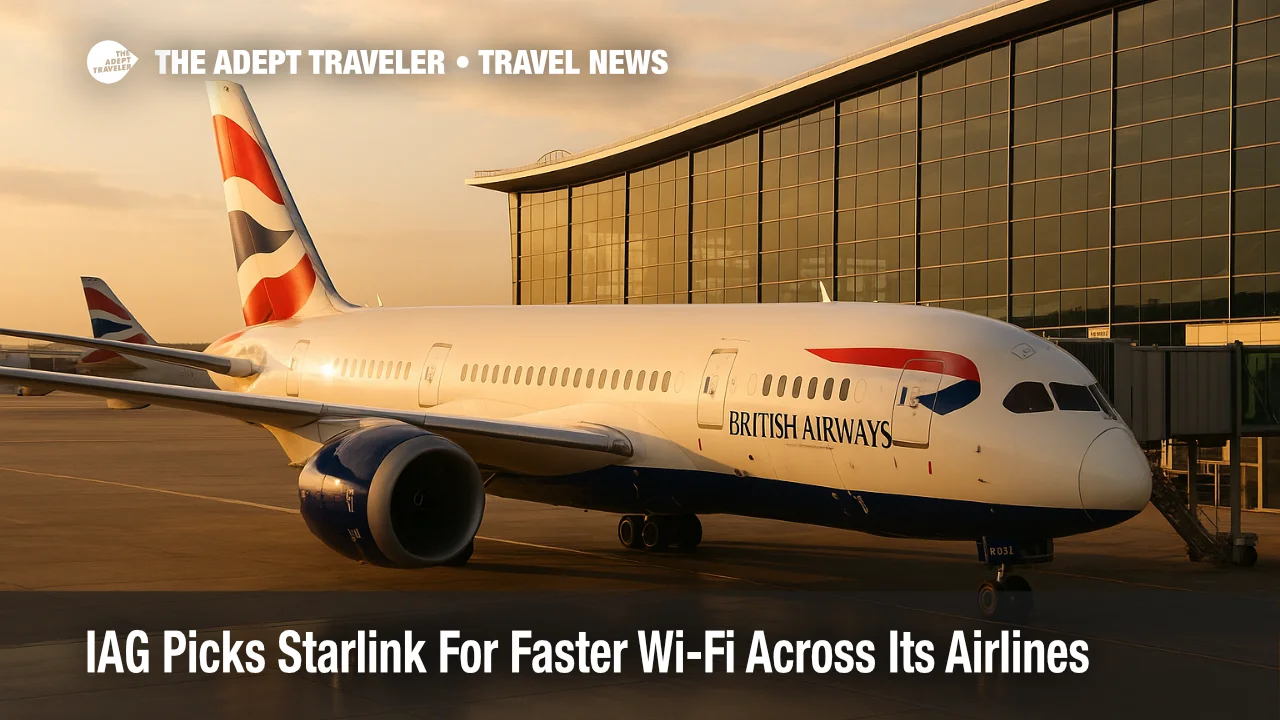IAG Picks Starlink For Faster Wi-Fi Across Its Airlines

Key points
- IAG will implement Starlink high-speed Wi-Fi across British Airways, Iberia, Aer Lingus, Level and Vueling
- Rollout covers more than 500 aircraft on European short-haul and all long-haul routes starting in early 2026
- IAG says its fleet is on track to have more high-speed Wi-Fi aircraft than any other European group
Impact
- Faster Cabin Wi-Fi
- Streaming, cloud apps and low-latency messaging will be supported once activated
- Rollout Starts Early 2026
- Airlines will publish aircraft-by-aircraft plans as schedules firm up
- Coverage On More Routes
- Short-haul in Europe and all long-haul transatlantic and global flights included
- Potential Fare & Access Policies
- Lines will confirm if access is free or tiered by cabin or status
- Device Readiness
- Most phones, tablets and laptops will connect without special apps
International Airlines Group, the parent of British Airways, Iberia, Aer Lingus, Level and Vueling, will deploy SpaceX's Starlink across more than 500 aircraft, adding high-speed inflight Wi-Fi to European short-haul and to all long-haul transatlantic and global routes. The first aircraft are slated to go live in early 2026, with implementation plans to be announced airline by airline as the program ramps. IAG says the upgrade positions its fleet to include more high-speed Wi-Fi aircraft than any other European airline group.
What changed and why it matters
IAG has signed a group-wide agreement to bring Starlink's satellite-based connectivity to narrow-body and wide-body fleets across its five branded carriers. For travelers, that means faster page loads, smoother video streaming, and enough bandwidth for cloud work and real-time messaging once the service is switched on. The company's notice highlights download speeds comparable to, or better than, typical home broadband, with low latency that improves responsiveness for modern apps.
How the rollout will work
The program begins in early 2026, with the exact timing and aircraft sequencing to be published by each airline as installations progress. IAG states that all aircraft not headed for near-term retirement are eligible. Expect a phased cabin-by-cabin experience as frames rotate through modification lines, followed by route-specific activations once certification and coverage checks are complete. As with any cabin upgrade, mixed availability is likely during the first months, so some flights will offer legacy connectivity or none at all until retrofits catch up.
Performance travelers can expect
Starlink Aviation advertises high throughput and low latency made possible by a growing constellation of low-Earth-orbit satellites. IAG's release cites indicative speeds that enable fast downloads, HD streaming, and even online gaming. While real-world performance depends on aircraft hardware, beam load, and geography, independent airline deployments in 2024-2025 showed meaningful step-ups over legacy systems and reduced buffering on oceanic segments where traditional geostationary services can struggle. United, for example, secured FAA approvals to begin flying Starlink-equipped aircraft earlier this year, offering a benchmark for certification and service maturity on large fleets.
Policies and access
IAG's announcement centers on capability and scale; pricing or access policies, such as whether Wi-Fi will be free for all passengers, tiered by cabin, or tied to loyalty status, were not detailed at the group level. British Airways separately framed Starlink as part of its multibillion-pound transformation journey and signaled an intent to offer broad customer access, but final policy language and any airline-specific exceptions will be confirmed as rollouts begin. Travelers should watch pre-departure emails and onboard portal screens for the definitive offer on their particular flight.
Background
Inflight connectivity, or IFC, has evolved from slow, zone-based links to higher-throughput satellite networks that support video, calls over Wi-Fi, and collaboration tools. Starlink's low-Earth-orbit architecture reduces latency compared with geostationary satellites, which helps streaming stability and the snappiness of messaging and cloud apps. Airlines have moved toward fleet-wide, consistent connectivity as a competitive baseline on both short-haul and long-haul networks, with several carriers already certifying Starlink on multiple aircraft types. IAG's group deal follows that trend at European scale.
What to do if you are booked in 2026
If you are flying any IAG carrier next year, check your booking in the week before departure, then again at online check-in, for aircraft-specific Wi-Fi notes. Onboard, confirm the "Starlink" identifier on the portal landing page and look for the airline's posted access policy. If reliable work connectivity is critical, consider booking flights that have already been operated with Starlink for several weeks on the same aircraft type, since early activations sometimes see brief portal tweaks or capacity tuning. For long-haul trips, expect the biggest quality jump compared with prior oceanic links, but plan sensible offline fallbacks for time-sensitive tasks during the first months of the rollout.
Final thoughts
IAG's Starlink deployment brings high-speed Wi-Fi to the group's European and global networks starting in early 2026. As installations spread across British Airways, Iberia, Aer Lingus, Level and Vueling, travelers should see faster, more reliable connectivity on both short-haul hops and long-haul crossings, with airline-specific access details to follow.
Sources
- IAG announces strategic investment in wi-fi connectivity for 500 plus aircraft
- British Airways signs major deal with Starlink
- United receives FAA approval for first Starlink-equipped airplanes
- IAG to roll out Starlink high-speed Wi-Fi across 500 plus aircraft from 2026
- IAG taps Starlink to power inflight Wi-Fi for 500 plus aircraft
